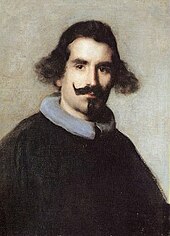Goatee

The mustache or Osirian beard , even after the eponymous Italian king and bearded Victor-Emanuel -Bart even Musketierbart or in English-speaking Van Dyke beard or shortly called Vandyke, a beard shape with a beard with a twirled mustache combined.
history
It was widespread according to the Spanish fashion towards the end of the 16th century to the middle of the 17th century and was introduced by Napoléon III. resumed in the 19th century. This beard costume was most popular among the Spanish as well as the Dutch. It was particularly popular with people born at the end of the 16th century from high aristocratic circles or highly respected clergy. Initially still worn in connection with curly and thick head hair, the wearing of the toggle beard was later retained with long and open hair.
In Adelung's grammatical-critical dictionary of the High German dialect from 1796 it says that it was "formerly very common, is still worn by the hussars and some other war nations, and was formerly also called Gran" . The name comes from the comparison of the two twisted mustache sides with a snaffle toggle . According to Johann Georg Krünitz, a "specially prepared and blackened wax" was used for maintenance purposes, so-called "gag wax", to coat the beard with it and to give it its proper shape .
Known porters
- Anthonis van Dyck , Flemish painter and printmaker
- Buffalo Bill , American bison hunter
- Ferdinand II , Roman-German Emperor
- Ferdinand III. , Roman-German Emperor
- Friedrich V , King of Bohemia and Elector Palatinate
- Friedrich Heinrich , governor of the United Netherlands
- Georg Wilhelm , Elector of Brandenburg
- Cornelis de Graeff , Dutch statesman and diplomat
- Gustav II Adolf , King of Sweden
- Gerrit van Honthorst , Dutch painter
- Charles I , King of England, Scotland and Ireland
- Charles IX , King of Sweden
- Louis XIII , King of France and Navarre
- Maximilian I , Elector of Bavaria
- Cardinal Mazarin , French diplomat and cardinal
- Philip III , King of Spain
- Philip IV , King of Spain
- Cardinal Richelieu , French aristocrat and statesman
- Diego Velázquez , Spanish portrait painter
- Wallenstein , Commander in Chief of the Imperial Army in the Thirty Years War
- Wilhelm II. , German Kaiser (only after his abdication in Dutch exile)
Individual evidence
- ↑ Knebelbart, der , on zeno.org
- ^ Duden 7, Bibliographical Institute Mannheim 1963, ISBN 3411009071 , page 338
- ↑ gag = beard . In: Johann Georg Krünitz: Economic Encyclopedia . 1773-1858 ( online ).
- ↑ Pictorial evidence: Kaiser Wilhelm in exile . See "Blood must flow, a lot of blood" - quotes from and about Kaiser Wilhelm II. , On sueddeutsche.de